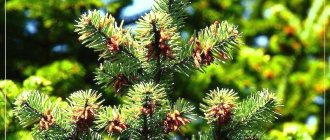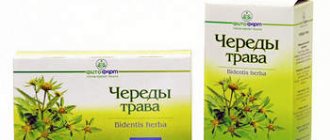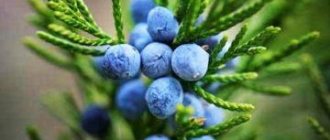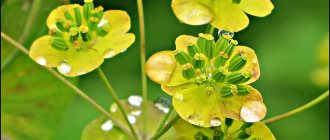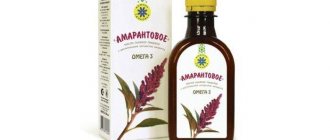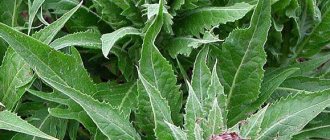Chemical composition
The properties of coniferous species are due to the biologically active nutrients contained in all parts of the juniper. In folk medicine, pharmacology and cosmetology, berries, pine needles, shoots, bark, wood, and roots are processed. Of all the varieties of coniferous species, it is permissible to use only common juniper.
On a note! The Cossack species has a similar external description, but its biochemical composition is very different, for example, in the high concentration of toxic substances that are hazardous to health.
Common juniper contains active components:
- pinene;
- cadinene;
- borneol;
- cedrol;
- resins;
- essential oil;
- malic, acetic, formic organic acids.
Of all the varieties of coniferous species, it is permissible to use only common juniper.
The beneficial properties are due to the vitamins, mineral nutrients, and tannins included in the composition. For various diseases, it is recommended to prepare healing remedies from parts of juniper. This is due to the fact that the qualitative and quantitative compositions vary depending on the component used.
Preparation
1 recipe. To take a bath, prepare a decoction of juniper twigs, cones and needles: pour 400-500 g of the mixture with boiling water. Boil for 30 minutes, the resulting broth is filtered and added to a bath with warm water (36-37 degrees).
2 recipe. 5-10 drops of juniper essential oil are diluted in 3-4 tablespoons of sea salt (or 1 teaspoon of castor oil), mixed and added to a bath with warm water (36-37 degrees).
10 drops for a full bath, 5-7 drops for a half bath, and 3-5 drops for hand or foot baths.
For children and the elderly, smaller dosages should be used: 3 times less for a children's bath, and 2 times less for an older person. Also, the dosage is reduced by half in case of taking preventive baths.
Baths should be taken in a course of 10-15 procedures lasting 10-20 minutes. Frequency of taking baths for non-acute rheumatic inflammation: 3-4 times a week at water temperature: 36-37 °C.
A mixture of juniper essential oil and salt is added immediately before taking a bath - if you add aromatic oils immediately, while the bath is still wet, there is a high probability that most of the oil will simply evaporate.
Beneficial features
The variety of substances contained explains the multifaceted effects on humans. Active nutrients affect almost all organs and tissues of the body and normalize many physiological processes. Even walks through the juniper forest are considered therapeutic. The released phytoncides cure pathologies of the respiratory and nervous systems.
List of the main beneficial properties of common juniper:
- antimicrobial;
- expectorant;
- restorative;
- diuretic;
- choleretic;
- anti-inflammatory;
- blood purifying;
- thinning;
- soothing;
- painkiller.
Walking in the forest and aromatherapy help cope with stress, nervous tension, and insomnia.
Medicines with juniper are prescribed for cystitis, laryngitis, tracheitis, bronchitis, gastroenteritis, urolithiasis, hepatopathy. Walking in the forest and aromatherapy help cope with stress, nervous tension, and insomnia. The diuretic property is used for edema. Rectal use normalizes metabolism, promoting weight loss, but at the same time increases appetite.
Juniper, beneficial properties of the plant and its use
29.05.2019 Common juniper
(lat.
Juníperus commúnis
, Cypress family) - one of the many representatives of the genus
Juniper
, which unites up to 75 species of relict coniferous evergreen plants of a bushy or tree-like form.
Also known as veres
,
juniper
,
yalovets
, etc.
Growing wild, the plant is found in pine forests and woodlands, on rocky slopes, heathlands, sandy, clayey, wetlands, and in mountainous areas, where juniper can grow at an altitude of up to 4050 m above sea level. Its natural growth area covers most of the Northern Hemisphere (Europe, Minor, Central, East and North Asia, North Africa and North America).
Junipers are characterized by relatively slow growth and impressive longevity - they can reach an age of 600 years or more. The plants themselves have existed on our planet for about 50 million years. In the Atlas Mountains (northwest Africa), relict populations of this culture have survived to this day.
Juniper adapts well to unfavorable environmental conditions. It is characterized by high frost resistance, undemanding soil characteristics, and drought resistance. A powerful root system, going tens of meters deep, allows the plant to cope with long periods without precipitation. Juniper is quite light-loving, but can grow, although not so successfully, in shade. It also does not tolerate high levels of gas pollution, soot and dust, so it does not always take root in urban environments. Cold, dry winds are also dangerous for it.
The leaves of juniper are 8–10 mm long, spiny, needle-like, covered with a waxy coating on top and bright green underneath. They are stored on branches for 4 years. They contain ascorbic acid (about 0.25 - 0.27%), essential oil with phytoncides, tannins and dyes, resins. Plants are dioecious (less often monoecious). Juniper blooms in late spring - mid-summer, forming flowers in the form of yellow cones. Wind pollinated. The first fruiting occurs no earlier than at the age of five or even ten. Maximum yields are achieved in the third to fifth year from the beginning of fruiting and amount to more than 50 kg/ha of berries.
The fruits are fleshy, berry-shaped cones - cones.
, which ripen only in the second year (within 18 months) or the third year after pollination. When ripe, they look like spherical berries, the diameter of which reaches 4–12 mm. Inside three or six scales that have grown and closed with each other there are three, sometimes two, triangular, yellowish-brown seeds. The dark, almost black skin is covered with a bluish coating on top, which is why the color of the berries is close to blue or gray-blue. They are collected in the fall, in dry weather, knocking them off thorny branches, and then dried in a well-ventilated room, at a temperature not exceeding +30°C. Dried raw materials are stored in tight containers that can protect the berries from moths and rodents.
An essential oil (0.5–2%) was found in juniper fruits, which contains monoterpene hydrocarbons (α-pinene, β-pinene, myrcene, sabinene, limonene, camphene, terpinolene, borneol, isoborneol, unipercamphor, etc.), resins (about 9%), organic acids (including formic, glycolic, acetic, malic), sugars (30 - 40%), wax (0.6 - 0.7%), tannins, pectins, pentosans (about 6%), inositol alcohol, pigments, essential elements (aluminum, potassium, manganese, iron), phytoncides.
Juniper is unique for its unsurpassed bactericidal properties. During the day, it releases essential oils that saturate the air with a huge amount of phytoncides. In this, juniper is superior not only to deciduous trees (on average 15 times), but also to all conifers (6 times or more). This property has long been used by Indian tribes to treat bronchopulmonary diseases and all forms of tuberculosis. In Europe, juniper branches were brought into the house and fumigated with them, thus escaping from deadly epidemics.
A juniper grove with an area of 1 hectare releases in 24 hours about 30 kg of volatile substances saturated with phytoncides, thanks to which the number of pathogens in the environment decreases by more than 200 times! Juniper not only kills harmful bacteria, but also slows down the aging process of the body, normalizes the functioning of the digestive, cardiovascular, and nervous systems, and has a beneficial effect on the human psyche.
The use of juniper preparations in folk medicine goes back thousands of years. Common juniper has a mild degree of toxicity, so it is important to follow the exact dosage when consuming it. Ripe (dry or fresh) berries are used for treatment, from which decoctions, tinctures, and essences are prepared. In addition to berries, the needles, roots and young stems of the plant have a healing effect.
In scientific medicine, they mainly use the fruits and juniper oil, alcohol, and tinctures obtained from them, which help in the treatment of chronic inflammatory processes of the upper respiratory tract, as well as infectious diseases of the digestive and genitourinary systems, activate the formation of gastric juice and improve intestinal motility, normalize metabolic processes, By regulating water-salt metabolism, they have an analgesic effect in rheumatism and gout. Juniper is also well known as a choleretic, anti-inflammatory, and diuretic agent.
At the same time, we must not forget about the restrictions: the use of pine cones is contraindicated during pregnancy and in the case of acute inflammatory kidney diseases (nephritis, nephrosonephritis)
.
In addition to medicinal use, juniper has long been used in cooking. Its berries are a popular spice in many European cuisines, including in Alpine countries where they are ubiquitous. For example, juniper berries together with caraway seeds promote the active process of lactic acid fermentation when sauerkraut is sauerkraut. Because of their astringent and bitter taste, raw berries are not eaten, but in dried and crushed form they are often added as a spice to meat (especially game), vegetable, fish, mushroom dishes, in preserves, sauces, and fillings.
The taste properties of juniper berries are quite strong and bright; too much of this seasoning can spoil the dish, so you should limit their quantity and use it within reasonable limits. Juniper in cooking goes well with pepper, marjoram and bay leaves, as well as some citrus fruits and fruits.
In addition to its food purpose, juniper serves as an excellent preservative, protecting food from spoilage. In the old days, juniper bark was used in some countries to make dishes for storing meat and dairy products. In Scandinavia, juniper wood is still used for this purpose. It is used to make small containers for storing butter and cheese, and to make wooden butter knives.
Juniper branches (and sometimes berries) are traditionally used in Scandinavia to flavor and preserve beer. Their use in brewing has been practiced in much of northern Europe for a very long time. Gin, one of the most famous spirits in the world, even owes its name to juniper: translated from French ( genievre)
it means
juniper
. It is juniper berries that determine the characteristic taste of this drink.
Juniper wood is also of considerable value. It is very resistant to atmospheric influences, is characterized by high biostability, strength, has a fairly dense structure (on average 0.55 g/cm3), beautiful texture and retains its pleasant aroma for a long time. Brown and red dyes are obtained from it. Natural reserves of wood are insignificant and do not allow its use in industrial production, but it has found application in the manufacture of small furniture, turning and wood carving (souvenirs, toys, cutlery, canes, etc.). Also, due to its qualities, this wood is often used in shipbuilding.
In cultivated plantings, juniper is grown as a medicinal plant and as an ornamental crop in green areas, botanical gardens, and landscape architecture. It is used for landscaping parks, squares, urban landscapes, and for creating health alleys and groves in sanatorium and resort areas. The variety of species and varieties of the plant allows it to be used as a crop for creating green hedges (shrubs with a narrow pyramidal or columnar crown), mixed borders, alpine slides, rockeries (low-growing dwarf and groundcover shrubs), alley plantings (tree-like varieties with a compact crown shape) and etc.
Beautiful dark green juniper needles serve as a shading background for bright, elegant flower beds, variegated plants, and flowering shrubs. A special decoration of gardening plantings are juniper varieties, distinguished by bright yellow, brownish, cream, bluish-green, silver, gray-blue needles, as well as unusual, drooping shoots. All these numerous varieties of the plant, its ease of care and high adaptive qualities make it possible to use it as a universal ornamental crop.
Juniper propagates by seeds, layering (mainly ground cover species), cuttings and grafting. Seeds must be stratified for at least 5 months before planting. The plant is light-loving, although it can grow in light shade. Dwarf forms of juniper and bonsai can be grown indoors. Light, fertile, lime-rich soils are favorable for the plant. All forms of juniper tolerate pruning and crown shaping well.
Use in folk medicine
Since all parts of juniper have healing properties, there are many ways to use it to solve health problems. They often make infusions and tinctures, arrange aromatherapy sessions and baths. For respiratory diseases, inhalation with a decoction is indispensable. Medicinal raw materials can be collected in the forest or purchased at the pharmacy.
Traditional medicine uses the properties of juniper to cure cystitis, colds, and joint diseases. The products soothe toothache and normalize the functionality of the circulatory and cardiovascular systems. Strengthening intestinal motility helps alleviate the condition of colitis and periodic constipation. Juniper helps heal wounds and ulcers, cope with tuberculosis, and relieves asthmatic attacks.
All parts of juniper have healing properties.
The fruits are recommended to be consumed fresh or added to teas and decoctions to stimulate performance, memory, eliminate liver and spleen dysfunction, and thin the blood. Infusions and tinctures are also prepared from cone berries. The following treatment regimen is often used - chew 1 berry on day 1, increase the dosage by 1 piece on days 2-14, eat 15 berries on day 15, then reduce the amount by 1 piece every day. Thus, the course of treatment is 1 month.
Pharmaceutical essential oil is used for massages, compresses, baths, aromatherapy, but it is not advisable to use rectally. The bark and roots are recommended for preparing healing remedies to relieve inflammation and restore intestinal microflora. The medicinal properties of juniper needles make it possible to use it to increase the body's defenses, prevent the growth of cancer cells, and normalize the functioning of the thyroid gland.
For cystitis
The therapeutic course is 2-3 weeks depending on the severity of the disease.
Ingredients:
- fresh or dried juniper cones - 1 tbsp.;
- boiled water.
Method of preparation and dosage regimen:
Chop the berries, pour into a saucepan, add 1 glass of hot water. Cook for 15 minutes. in a water bath, cool with the lid closed. Strain through cheesecloth, bring the resulting volume of broth to 200 ml with boiled water at room temperature. The product can be stored in the refrigerator for no more than 2 days. Apply 1 tbsp. l. after meals 4 times a day. The therapeutic course is 2-3 weeks depending on the severity of the disease. Additionally, it is necessary to ensure plenty of drinking water.
For a cold
Juniper is used to treat the upper and lower respiratory tract.
Juniper is used to treat the upper and lower respiratory tract due to its antiviral, antimicrobial, expectorant and tonic properties. Essential oil is most often used for aromatherapy; it is permissible to dilute 1 drop in honey, water, or drop it on a piece of bread and use it orally. Externally prescribed for rubbing the chest and back. To prepare a solution for inhalation, it is recommended to take pine needles or oil.
For colds and bronchitis, a decoction can be prepared as an expectorant. 1-1.5 tbsp. l. dried berries, pour 200 ml of boiling water, boil in a saucepan for 5-10 minutes. Cool with the lid closed and strain through cheesecloth. Take 3 times a day, 1 tbsp. l.
For joints
In addition to joint diseases, it helps cope with various types of pain.
The most effective form of juniper preparation is tincture. Its properties are well demonstrated when rubbed. In addition to joint diseases, it helps to cope with various types of pain; it is prescribed internally for chronic diseases of the gastrointestinal tract and urinary system.
Ingredients:
- vegetable raw materials – 1 part;
- alcohol 70% - 7 parts.
Manufacturing:
Pour the prepared raw materials with alcohol and leave in a warm place, protected from direct sunlight for a week. Shake the contents of the jar periodically. The course of treatment is 2-4 weeks.
Homemade Juniper Remedies
The properties of juniper allow it to be used as part of diuretic preparations, for which the berries of the plant, birch leaves and dandelion root are taken in equal parts, mixed and poured with boiling water in the proportion of 1 tablespoon of the mixture per glass of water. The strained infusion is taken three times a day before meals, a tablespoon.
For stomach ulcers, a decoction of juniper roots is indicated. A tablespoon of medicinal raw material is poured into 100 ml of boiling water and continued to boil for 15-20 minutes under the lid. Leave for 15-20 minutes, strain and take 1 tbsp. l. 3 times a day before meals.
Fresh berries are used as an antidiabetic agent and to improve blood. To do this, chew one berry every day on an empty stomach, adding one more every day. When the daily dose reaches 15 berries, they begin to reduce it - also one berry per day.
An infusion of fruits (10-12 berries per glass of boiling water, infused for 4 hours) is taken a tablespoon three to four times a day for bronchitis, colds, edema of cardiac origin, gastrointestinal atony, bloating, cholelithiasis. The same infusion can be used as an external remedy for pain in joints and muscles.
Application in cosmetology
Plant oil is added to cosmetic products and baths.
The healing properties of juniper are used for healthy skin and hair. Plant oil is added to cosmetic products and baths. You can make masks from fresh berries. Dried fruits are suitable for lotion - 4 tbsp. l. grind in a coffee grinder, pour 250 ml of boiling water, wrap it in a towel, leave for 1 hour, strain. Mix the infusion with 1 tbsp. l. glycerin and 100 ml of alcohol. Use the product for a month to wipe the skin 1-2 times a day.
Properties of juniper-based cosmetics:
- moisturizing, cleansing, rejuvenating the skin;
- reduction of swelling and irritation;
- stimulation of restoration processes in cells;
- improvement of complexion;
- normalization of the excretory function of the sebaceous glands;
- narrowing of pores;
- smoothing wrinkles;
- strengthening, stimulating hair growth;
- getting rid of dandruff;
- eliminating itching.
On a note! Before external use, you must do an allergy test. To do this, apply a small amount of the product to the elbow bend and leave for 15-20 minutes. In the absence of allergic reactions, it is permissible to use it for its intended purpose.
For face
Cosmetics based on it treat acne, tighten pores, dry out acne, and remove black and white comedones.
Due to its healing properties, juniper extract is indicated for use with oily skin types. Cosmetics based on it treat acne, tighten pores, dry out acne, and remove black and white comedones. In reduced concentration it is permissible to use for all skin types. As part of masks, creams, lotions, it increases turgor, fights wrinkles and signs of aging.
Ingredients for preparing a toning mask:
- Common juniper berries crushed with a coffee grinder - 1 tbsp. l.;
- boiled or purified water – 200 ml;
- oatmeal - 1 tbsp. l.
Preparation method:
Boil plant materials with water on low heat for 5 minutes. under a closed lid. Leave to infuse for 30 minutes, strain. Mix 40 ml of the resulting broth with oatmeal crushed in a coffee grinder. Apply to cleansed face and neck skin for 20 minutes. Rinse with warm water, fix the effect with moisturizer.
For hair
Juniper helps cope with hair loss, making even weakened and thinning hair stronger, healthier and shinier.
The properties of juniper cones are used to treat dandruff and baldness. It is recommended to make an ointment from fresh fruits and lard. Mix the ingredients, heat in a water bath for 1 hour, strain, cool. Rub into the scalp every day for 10-15 minutes. This remedy can also reduce warts by treating them every day for 2 weeks.
Juniper exhibits healing properties against seborrhea and weeping eczema, helps cope with hair loss, and makes even weakened and thinned hair stronger, healthier and shinier. Some of the medicinal properties are due to the manganese, iron and copper content. The first element makes hair soft, iron is responsible for providing the scalp with oxygen, copper prevents the appearance of gray hair.
For weight loss
Juniper essential oil helps reduce weight.
Juniper essential oil, used for aromatherapy, massages, anti-cellulite products, and baths, helps reduce weight. Thanks to its property of accelerating metabolism, it starts the process of losing weight. Traditional medicine recommends preparing a snuff mixture - add a few drops of juniper oil to coarse salt and close tightly. Breathe in the morning, during your lunch break.
To take a bath, pour water, add 8-10 drops of ether mixed with salt or honey. This preparation will help the active component dissolve better. The procedure is useful for reducing the volume of the abdomen and thighs; beneficial properties also appear against varicose veins and hemorrhoids.
Features of juniper as a medicinal plant
What benefits does juniper bring to the human body? Does it have any contraindications? What types of it are used as medicinal raw materials? What parts of the plant can be used?
Area
The distribution zone of most species is the temperate climate of the northern hemisphere. In addition to Europe, North America, subtropical mountainous regions of Asia (Pakistan, Nepal, Northern India), the plant is found in North Africa. Common juniper loves dry, sandy soils, limestone, mountain slopes, hills, undergrowth, clearings, forest edges, and banks of water bodies. It is less commonly seen in swampy areas and dense forests. In Russia it is found in the forest and less often in the forest-steppe zone; in the east its range extends to the banks of the Lena River. Many species have limited habitats - for example, Crimean, Mexican, East African, coastal, Chinese, Californian, Bermuda, Tibetan and others.
Botanical characteristics
This is an evergreen coniferous plant. It occurs in the form of a shrub up to 2 m high or a slender columnar tree up to 5 meters in height with adjacent branches. The peculiarity of the plant is its hard and prickly needles up to 1 cm in length. The fruits of the plant (cone berries) ripen in the second or third year of life. At first they are green, then they become blue-black, fleshy, round (from 5 to 10 ml in diameter). Juniper blooms in May, and its fruits ripen in September-October.
Features of the workpiece
It is important to know that only ripe, blue-black fruits of the second or third year can be harvested. Harvesting begins in September. To do this, place a litter under a bush or tree and shake off the berries on it. After this, the fruits are cleared of twigs and needles. Dry only naturally - in attics, verandas, under awnings. When dried in an oven or electric dryer, the beneficial properties of juniper berries are lost. The raw materials are protected from dampness and packaged in tight containers to prevent evaporation of the essential oil. Shelf life: 3 years.
In addition, you can harvest pine needles, bark, wood, and juniper root. The bark and wood are especially useful for gout and rheumatism, they are used to cleanse the blood. The needles are used to treat respiratory infectious diseases, joint pain, and skin rashes. Treatment with juniper root has a positive effect on bronchitis, pulmonary tuberculosis, and skin diseases.
Common juniper. Botanical illustration from the book "Köhler's Medizinal-Pflanzen", 1887.
Cossack juniper. Botanical illustration from the book "Köhler's Medizinal-Pflanzen", 1887.
Crimean prickly juniper. Botanical illustration from the book "Köhler's Medizinal-Pflanzen", 1887.
Kinds
There are about 75 species of juniper. Many of them are grown for decorative purposes, cultivated in city gardens and parks, and on personal plots. What species, besides common juniper, are used in folk medicine?
- Cossack juniper. Most often found in the Carpathians and Crimea. This is a dangerous poisonous plant. It can only be used externally. Collect branches and berries of bushes. Infusions and decoctions are prepared from them to treat affected skin (lichen, scabies, skin cancer, radiation burns, boils). Also, douching is made from decoctions of Cossack juniper. These procedures are especially useful for trichomonas inflammation of the vagina. The powder is used to cover wounds, eczema, ulcers, and warts.
- Crimean juniper. This is the common name for five species growing in Crimea - tall, prickly, stinking, Cossack, common. Most often, the fruits of the Crimean prickly, or red juniper are harvested. Juniper oil is obtained from it, which is used not only in medicine, but also in cosmetology. And its fruits are known for their diuretic, stimulating, and anthelmintic effects. Other species are valued primarily for their timber.
Healing effect
What are the beneficial properties of juniper?
- Diuretic.
- Disinfectant.
- Secretory.
- Appetizing.
- Painkiller.
- Wound healing.
- Expectorant.
- Distracting.
- Anti-inflammatory.
- Blood purifying.
- Bactericidal.
- Calming.
Thanks to what beneficial substances does the plant acquire medicinal value?
- Medicinal properties of juniper berries. The fruits contain valuable essential oil, containing: sabinene, terpineol, pinene, borneol, uneol, camphor, cadinene and other substances. In addition, there are a lot of sugars, pectins, fatty oils, organic acids, glycosides, bitterness, waxes, resins, and dyes. Juniper cones also contain these same substances.
- Medicinal properties of juniper root. They, like wood, contain diterpene alcohols and tannins. They also contain substances with anti-inflammatory, bactericidal, and thinning properties.
- Juniper needles. It contains a lot of phytoncides that kill pathogenic bacteria. Therefore, it is useful not only to brew pine needles, but also to breathe juniper essential oil in natural conditions. It is believed that a hectare of bushes evaporates 30 kg of phytoncides per day. The needles also contain a lot of vitamin C, essential oil, and tannins.
Indications for use
What diseases are successfully treated with juniper grass?
- Urinary system. Juniper is one of the powerful diuretics of plant origin. Infusions and decoctions of the fruit are prescribed for chronic inflammation of the kidneys, bladder, stones, sand in the kidneys, severe swelling, dropsy, and for disinfection of the urinary tract.
- Digestion. The medicinal properties of juniper fruits are used in the treatment of digestive disorders. The herb increases appetite, normalizes peristalsis, relieves heartburn, nausea, vomiting, diarrhea, and flatulence. It is taken for diseases of the liver and biliary tract, anacid gastritis, and stomach ulcers. To normalize digestion, juniper berries can not only be brewed, but also chewed.
- Nervous system. The plant has a calming effect and relaxes the nervous system. Decoctions and infusions are recommended for neuroses and insomnia. It is useful to take pine baths before bed.
- Respiratory system. It thins mucus well, helps with bronchitis, pneumonia, and makes dry, obsessive cough productive. During epidemics of ARVI or influenza, it is useful to fumigate the room with smoke and conduct aromatherapy sessions.
- Musculoskeletal system. It helps well with inflammatory processes in joints, muscles and bones. For rheumatism, neuralgia, paralysis, tumors, it is taken orally and applied externally in the form of lotions and compresses.
- External use. Used as a bactericidal, wound-healing agent for dermatitis, lichen, scabies, eczema, boils, ulcers. It is also useful to rinse the mouth with decoctions for scurvy and inflammation of the gums. The tincture can be instilled into the ears for otitis media. Infusion and decoction can be used to gargle for tonsillitis and pharyngitis. For skin rashes, psoriasis, eczema, joint pain and neuroses, medicinal juniper baths are recommended.
Juniper is strictly contraindicated in acute inflammatory processes in the kidneys and digestive organs. Juniper-based medications should not be taken orally during pregnancy in any trimester, during lactation and in children. Sometimes there is individual intolerance to the berries of the bush. In case of overdose, allergies and digestive disorders are possible. When harvesting fruits, it is important to distinguish between types and remember the poisonous properties of Cossack juniper.
Contraindications and harm
For serious health problems, consult your doctor.
Treatment with common juniper should be carried out with caution, since the plant has toxic properties. It is dangerous to use other types of coniferous trees, as they may contain high levels of toxic substances. Before starting therapy, analyze the benefits and harms. For serious health problems, consult your doctor.
The plant is contraindicated for use in case of individual intolerance and allergic reactions. You cannot treat with juniper-based products during pregnancy and lactation. Aromatherapy is prohibited for acute kidney disease. It is important to follow the recommended dosages and not exceed the permissible course of treatment. Most products have healing properties when used for up to 3 weeks; longer is undesirable.
The plant has beneficial properties only when used in moderation.
Common juniper is a medicinal plant that affects many organs and tissues of the human body. It is important not to exceed the dosage prescribed by the herbalist and not to increase the course on your own. The plant has beneficial properties only when used in moderation, otherwise side effects may occur.
